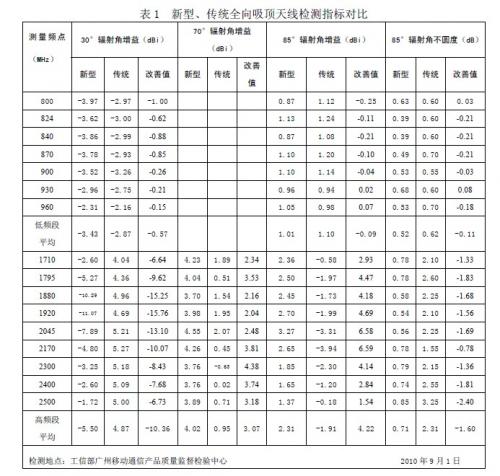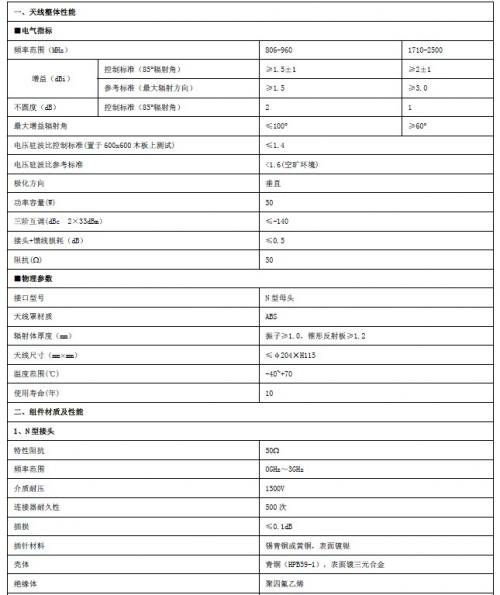Discussion on New Omnidirectional Ceiling Antenna Technology and Standards
Time:2023-04-29
Views:1052
1、 Overview
As early as the early stages of 3G experimental network construction, researchers discovered that 3G signals have fast attenuation, high penetration loss, and poor diffraction ability. In indoor distribution systems, 2G and 3G signal coverage cannot be synchronized, and 3G signal coverage is small, with many blind spots and weak areas. These issues are caused by the high frequency of 3G signals and are often considered insurmountable technical barriers. To obtain good 3G indoor signal, the only way is to increase antenna density. So, for 3G indoor distribution systems, the industry generally agrees with the design principle of "small power, multiple antennas". However, although this principle solves the problem of 3G signal coverage, it has led to a doubling of construction investment and large-scale renovation of 2G indoor distribution systems, while also leading to more serious 2G signal leakage.
Through long-term observation, testing, and research, we have found that traditional omnidirectional ceiling antennas have some technical defects, such as high-frequency signals gathering directly below the antenna, uneven signal distribution, and instability. The aggregation effect of high-frequency signals is the true technical reason for the rapid attenuation and small coverage radius of high-frequency signals such as 3G. Through technological research, repeated experiments, and continuous improvement of broadband antennas, we have developed a new type of omnidirectional ceiling mounted antenna that is broadband, efficient, energy-saving, and environmentally friendly.
The new omnidirectional ceiling antenna has expanded the working frequency band, reduced high-frequency signal electromagnetic radiation, doubled the coverage area of a single antenna, improved signal coverage uniformity, overcame technical barriers, made up for defects, improved coverage efficiency, greatly simplified the 3G indoor distribution system, changed the basic principles of 3G indoor construction, achieved synchronous coverage of all frequency bands and multiple networks, and avoided duplicate construction, Improved the utilization rate of indoor resources, effectively improved the overall efficiency of the entire indoor distribution system and indoor network quality, saved a large amount of network construction investment and operating costs, reduced costs, increased efficiency, energy conservation, low-carbon environmental protection, and significant social and economic benefits.
This article introduces the main technical characteristics of the new omnidirectional ceiling antenna and explores its technical standards.
2、 Main Technical Characteristics of New omnidirectional antenna Ceiling Mounted Antenna
The technical indicators for the detection of the new omnidirectional ceiling antenna are shown in Table 1. At the 85 ° radiation angle corresponding to the edge of the coverage radius, the antenna gain in the high frequency range is 1dB~2dB higher than that in the low frequency range. Compared with traditional omnidirectional ceiling antennas, the average gain is increased by 4.22dB, effectively expanding the coverage range of high-frequency signals. Coupled with the advantages of 3G system CDMA technology, the coverage range of 2G and 3G signals is basically the same, changing the principle of "small power, multi antenna" 3G compartment design.
The strongest high-frequency signal radiation corresponds to the 30 ° radiation angle below the antenna. The average gain of the antenna in the high frequency band is -5.5dB. Compared with the traditional omnidirectional ceiling antenna, the average gain is reduced by 10dB, which effectively reduces the electromagnetic radiation and increases the minimum Coupling loss. Therefore, the radiation is reduced and the allowable value of the signal power fed into the antenna port is increased.
By appropriately designing the antenna coverage radius and adjusting the feed power of the antenna port, communication systems with different edge field strength requirements in the high and low frequency bands can be synchronously covered, solving the technical problem of asynchronous coverage in 2G and 3G networks, and breaking through the technical barriers of sharing multiple systems in indoor distribution systems.
In addition, the new omnidirectional ceiling antenna has a simple structure and is completely axisymmetric. The 85 ° radiation angle non circularity can be controlled within 1dB, the signal distribution is more uniform, and the working bandwidth is wider. The main technological innovations of the new omnidirectional ceiling antenna include:
(1) Breaking through the mindset, we first discovered and confirmed the technical shortcomings of traditional antennas, and identified the true technical reasons for the rapid attenuation of 3G signals.
(2) The technical indicators of radiation angle gain and radiation angle out of roundness are proposed, and 30 ° and 85 ° radiation angles are defined as typical angles to measure the technical performance of omnidirectional antenna under and at the coverage edge, which more accurately reflects the signal coverage uniformity and stability of omnidirectional antenna, improves the omnidirectional antenna index system, and enriches the antenna
Technical theory.
(3) In terms of design idea, it breaks through the design concept of traditional omnidirectional ceiling antenna that only pursues high gain, and focuses on the uniformity and stability of signal distribution and the consistency of full band signal coverage edge field strength in the actual application of the antenna.
(4) In broadband antenna technology, a clever combination of a half wave oscillator and a biconical antenna is used, with a half wave oscillator in the low frequency range and a biconical antenna in the high frequency range. This avoids the problem of significant differences in the vertical patterns of dipole antennas at high and low frequencies, and adjusts the maximum gain radiation angle of the high-frequency signal to around 70 °. This strengthens the signal at the edge of the target coverage radius, solves the problem of high-frequency signal aggregation, expands the coverage range, and improves coverage efficiency, At the same time, it effectively alleviates electromagnetic radiation near the antenna.
(5) A higher intermodulation index requirement has been proposed, with third-order intermodulation less than -140dBc, effectively reducing intermodulation interference between systems when multiple systems are combined.
(6) The design is precise, eliminating impedance matching pieces (wires) and lightning protection grounding of the oscillator. The structure is simple and symmetrical, without the need for impedance testing, easy to produce and assemble, convenient for large-scale production, good product consistency and stability, and low out of roundness indicators.
(7) Clear technical performance indicators, manufacturing materials, and component quality requirements have been established, with controllable quality and clear costs.
(8) Expanded the working bandwidth (800MHz to 3000MHz), extending it by 500MHz compared to traditional antennas at the high-end, facilitating WLAN access and network evolution towards LTE, avoiding further modifications.

3、 Discussion on Technical Standards for Indoor Omnidirectional Ceiling Mounted Antennas
GB/T 9410-2008 General technology Specification for Mobile Communication Antennas and GB/T 21195-2007 Technical Conditions for Antenna of Mobile Communication Indoor Signal Distribution System put forward technical requirements for our indoor omnidirectional ceiling antenna, but the current standards have the following shortcomings:
(1) The electrical performance requirements for indoor omnidirectional ceiling antennas are proposed in Table 1 of Article 5.1 of GB/T 9410-2008, but only the gain is specified without specifying the direction of maximum gain. The high out of roundness index and different radiation angles are used in the low frequency range, which cannot truly reflect the coverage performance of indoor distribution systems on omnidirectional ceiling antenna signals. real
In fact, increasing the high radiation angle gain and circularity corresponding to the coverage edge is beneficial, while low radiation angle gain and high radiation angle gain enhance radiation, which is not beneficial.
(2) Article 4.1.3 of GB/T 9410-2008 mentions the requirements for antenna materials, but in reality, there are no clear technical specifications for the material and performance of antenna components, resulting in uneven quality of mobile communication antennas and vicious price competition, which is not conducive to the healthy development of the industry.
(3) Article 4.1.4 of GB/T 9410-2008 states that "antenna design should be conducive to lightning protection", while Article 5.1.5 of GB/T 21195-2007 states that "lightning protection requirements: directly grounded", which is consistent with Article 5.1 of YD/T 1059-2004 "Technical Conditions for Base Station Antennas in Mobile Communication Systems". The lightning protection requirements for indoor and outdoor antennas are completely equivalent. Obviously, the current standards do not consider the differences between indoor and outdoor. In fact, outdoor antennas are generally installed at the top of buildings and towers, with large antenna scales and a high probability of direct lightning strikes. Therefore, the requirement for direct grounding of antenna oscillators is reasonable. However, for indoor antennas, the antenna oscillator has a small volume and is installed inside buildings. Generally, buildings have lightning protection measures, and the possibility of indoor lightning strikes is extremely low. Therefore, the grounding requirements for the oscillator are not significant.
In order to more accurately describe the actual coverage performance of indoor omnidirectional ceiling antennas, the new omnidirectional ceiling antenna introduces radiation angle gain and radiation angle out of roundness indicators. Based on the actual signal coverage distribution in indoor scenes, 85 ° and 30 ° radiation angles are defined as typical angles for high and low radiation angles of the antenna. 85 ° radiation angle represents the edge of the antenna coverage radius, and 30 ° radiation angle represents the corresponding angle of the strongest radiation below the antenna. The higher the gain of the 85 ° radiation angle of the antenna, the stronger the coverage radius edge signal, and the wider the coverage range of a single antenna. The lower the non circularity of the 85 ° radiation angle, the more stable the coverage radius edge signal; The lower the 30 ° radiation angle gain of the antenna, the more
The smaller the electromagnetic radiation below the antenna, the more uniform the indoor signal distribution.
In order to more accurately reflect the actual coverage performance of indoor omnidirectional ceiling antennas in indoor distribution systems, unify product performance and quality requirements, and based on the technical specifications of GB/T 21195-2007, we have developed the main technical indicators of the new omnidirectional ceiling antenna, as shown in Table 2. Compared with the overall technical performance of the antenna, the new omnidirectional ceiling antenna specifies different coverage angle gains and coverage edge non circularity in its technical indicators, and unifies the high and low frequency band gains and non circularity control indicators to 85 ° radiation angle, making it easier to reflect the uniformity and stability of signal distribution. Clear regulations have been made for the material and performance of antenna components, as well as for the new omnidirectional ceiling mounted antenna, which is conducive to standardized production and unified quality control standards for products.


Table 2 Main Technical Indicators of the New Omnidirectional Ceiling Antenna (China Unicom Provisional Standards)
Four concluding remarks
The new omnidirectional ceiling antenna has changed the high-frequency technical performance, broken through the technical barriers of asynchronous 2G and 3G network coverage, solved the technical problem of indoor distribution system multi system sharing, changed the basic principles of 3G indoor distribution system design, and brought fundamental changes to the construction of 3G indoor distribution system. It is a substitute product for traditional omnidirectional ceiling antennas. The new omnidirectional ceiling antenna has been promoted and applied in China Unicom. China Unicom has formulated enterprise standards for the technical indicators of the new omnidirectional ceiling antenna and is actively promoting the formation of industry, national, and international standards as soon as possible to promote the healthy development of the global telecommunications industry.
|
Disclaimer: This article is transferred from other platforms and does not represent the views and positions of this site. If there is any infringement or objection, please contact us to delete it. thank you! |











